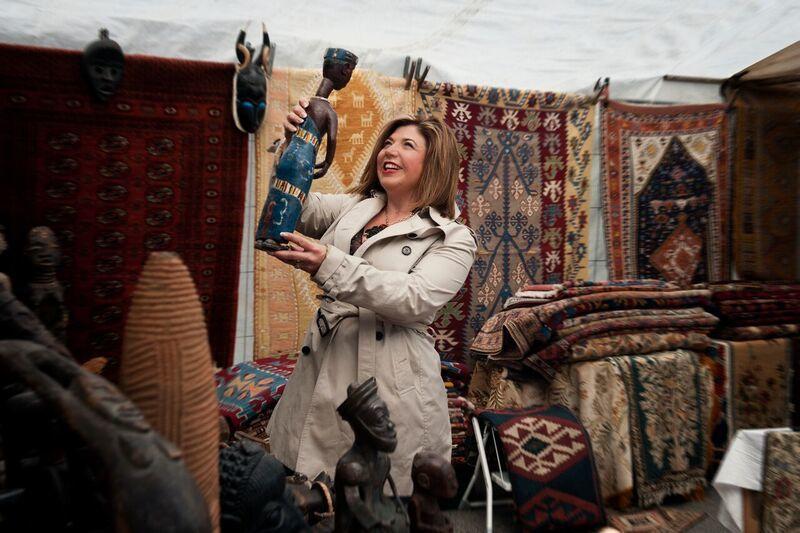When traced back to its French origins, the word souvenir translates to “memory,” explained Toma Clark Haines, CEO of The Antiques Diva Co., at the recent panel “European Treasures, Discovered.” “I love it, because that’s what you actually do when you’re buying antiques overseas. You’re buying memories,” said Haines at the Designer Forum Series event, a new initiative presented by the D&D Building.
The self-described Antiques Diva, whose antiques tour company celebrates its 10th anniversary this year, was joined by designers Garrow Kedigian and Robert Passal to share their expert tips for shopping the European antique markets. Take notes as EAL reveals their best-kept secrets for sourcing with a client, negotiating the best deal and transporting your finds back to the U.S.

On Shopping for (or With) a Client
Garrow Kedigian: I have skeptical clients who think, “Oh, we’re not going to find anything in Paris. Paris is so fancy.” So I always take my clients shopping in New York before we go to Paris. I specifically take them to showrooms that we love, knowing we can present them with similar pieces in Paris at a fraction of the cost. It helps in the negotiation factor.
Robert Passal: It’s important to pre-shop. Whether I’m at an antique market or I have a client in town, I always pre-shop, because that’s what we’re being hired for is to edit.
GK: I’ll send [a photo] and say, “These pieces are perfect for these locations. You send them a furniture plan and tell them that by the end of the day on Saturday, you need to email me back and say yes or no.” I find that a lot of indecisive clients will actually make a decision.
On the Best Time to Go
Toma Clark Haines: When not to go is probably more important. In the month of May, there are three Catholic holidays, which means there are three weekends of the month that the country closes down. July 15 to around August 15 is difficult, because there are less vendors.

GK: I always have the best success in September. And I usually push clients to go shopping early on in a project. We always work out our furniture plans early because it will take a few months to [ship] stuff over.
On the Best Markets to Shop
TCH: If you’re only going to shop one place, I’d say shop in England. For hundreds of years, the Brits have been collectors, and you can go to one place and find the best of everything in one location.
On Negotiating a Deal
TCH: Each country has different negotiating tactics and techniques. It’s knowing what makes the vendor in that specific location tick. In Italy, you have to build a rapport with the vendor before negotiating. In the Netherlands, the Dutch do not like to give discounts. Knowing the local mentality is probably the most important thing you can do to get the best price.
I also give my client a safe word, because sometimes the client is so excited that I think, “Oh, my god, they’re going to pay twice what they need to pay because I know that three days [ago] they had it priced at something else. Sometimes you need your client to keep quiet so you can negotiate.”
RP: I think the clients like when they think you’re doing the best you can for them when you negotiate for them in front of them. It depends on the client, but I like the transparency.

On What to Expect for Shipping Estimates
TCH: Be prepared that it’s going to take a long time. Your shippers are probably going to say you’ll have it in a month, and in theory, that’s true, because it’s 25 days at sea. However, what that doesn’t account for is how long it takes for your money to get to the vendor, then your shipper to collect it from the vendor and then to wrap it in their warehouse, so I always tell clients: Expect two months, be prepared for three months.
The fact is, they can’t estimate shipping before you’ve bought. If you’re going in blind and just buying a few items, you’ve got to be aware that the shipping is not going to be cheap. Where you save money: Go big or go home is always my theory. Buy a container. A full container can cost you about $15,000, so if you’re buying 40 to 50 pieces, suddenly that container cost is negligible. That’s when you save money.
Another place is your collection points. If you’re at the Paris flea market, it’s nice because it’s all in one place, but many of our clients are doing multiple countries in three to five days. At every store, there’s a fee for someone going and picking it up. When you buy something from one vendor, maybe rather than negotiating a discount, you say, “Will you bring it over to this vendor that’s an hour away so that I only have to pay one collection fee?” And honestly, I think crate costs is where shippers rip people off. Each crate runs about $350. You have to decide what your comfort level is for risk. Are you will to have something happen to that item?
GK: It’s true. I recently bought this very cool tandem bicycle, but it really doesn’t have an intrinsic value. It’s just a cool object. The clients came back to me and said, “We’re going to wrap it in a crate,” and I said, “No, no, no.” We wrapped it in some paper, and that decreased the cost by 50 percent on shipping.
On Best-Kept Secrets
TCH: When you go to the antique shows, tell the dealer, “I love what you have, but you don’t have what I’m looking for. What do you have at home?” That’s what I ask every antique dealer. If I ever go missing, it’s because I’m a person who follows people down dark alleys in pursuit of antiques!



























